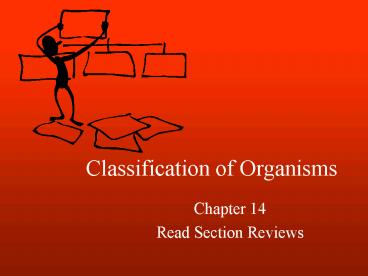Classification of Organisms - PowerPoint PPT Presentation
1 / 14
Title:
Classification of Organisms
Description:
Taxonomy is the science of naming and classifying organisms. ... Plantae multicellular, autotrophic, cell walls contain cellulose. ... – PowerPoint PPT presentation
Number of Views:433
Avg rating:3.0/5.0
Title: Classification of Organisms
1
Classification of Organisms
- Chapter 14
- Read Section Reviews
2
Why Classify
- Taxonomy is the science of naming and classifying
organisms. - Scientists must use a classification system that
names orders the organisms in a logical manner. - There are two factors to a good classification
system. - Must have a universally accepted name.
- Place organisms in groups with real biological
meaning. - The groups are expected to share important
traits. - In the 1700s common names were replaced by Latin
or ancient Greek names - The names described the organisms were too
long. - This system was difficult to standardize.
3
Carolus Linnaeus
- Carolus Linnaeus developed Binominal
Nomenclature. - Every organism has a two part name.
- The first part is the genus it describes a
small group to which the organism belongs. - The second is the species usually describes a
special trait. - The genus is Capitalized and the species is lower
case (usually in italics) - There is a committee which oversees the naming
process carefully selects a specimen.
4
How Linnaeus Creates his System
- Linnaeus organized all the known existing
organisms into binomial nomenclature. - He grouped organisms by shared body structures
- The groups he called Taxa (taxon)
- The science of naming these groups is called
taxonomy. - Linnaeus created an order from smallest to
largest.
5
The Groups
- Listed from smallest to largest
- Species- shared traits but different biological
units (may reproduce viable offspring) - Genus- similar structures
- Family- groups of genus with some variation in
structure. - Order- several families make an order, still
shared traits. - Class- orders are placed in classes, I.e.
mammalia - Phylum- large group consisting of different
animals yet share common characteristics - Kingdom- Two giant Taxa separating plants and
animals - Domains- groups of similar Kingdoms
6
The Six Kingdom System
- Monera has been split into Eubacteria
Archaebacteria which are prokaryotes. Early
forms lacked nuclei, mitochondria, chloroplast
and reproduced by binary fission - Protista are single celled eukaryotes with
membrane bound organelles. They are divided into
three categories. - Fungi cells have no cellulose in the cell walls,
they are heterotrophic, and may have many nuclei
in the same cell. - Plantae multicellular, autotrophic, cell walls
contain cellulose. - Animalia multicellular, cell membrane but no cell
wall, heterotrophic, and very diverse kingdom.
7
Hierarchy of Classification
8
Organisms Hierarchy
9
Taxonomy Today
- Phylogeny is the evolutionary history of an
organism. - Organisms are grouped in Cladograms by
evolutionary history not similarities in
structures. - Convergent Evolution can create organisms with
analogous structures which are not closely
related. - Cladistics determines phylogenies by comparing
and grouping organisms by characteristics - Ancestral characteristics evolved in a common
ancestor - Derived characteristics evolved in the ancestors
of one group but not the other.
10
Phylogenic Diagram of Mammals
11
Cladogram Mammals, Reptiles, and Birds
12
Cladogram Major Groups of Plants
13
Evolutionary Systematics
- Evolutionary Systematics provides varying degrees
of importance to certain characteristics. - Phylogenetic trees show this branching
relationship between organisms.
14
Evolutionary Systematics and Cladistic Taxonomy































